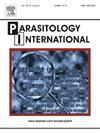Infection status of Baylisascaris transfuga in captive Asiatic black bears (Ursus thibetanus) from three bile farms in South Korea, with molecular analyses
IF 1.5
4区 医学
Q3 PARASITOLOGY
引用次数: 0
Abstract
Bears harbor various endoparasites that pose risks to humans and other animals. However, information on parasitic infections in Asiatic black bears in South Korea (Korea) is limited, and potential hazards still exist because of the close contact between bears and humans on bile farms. The present study was conducted to assess the gastrointestinal parasite infection status in captive Asiatic black bears (Ursus thibetanus) at bile farms in Korea. Additionally, we aimed to characterize the molecular aspects of Baylisascaris transfuga (Nematoda: Ascarididae), the sole species investigated throughout the study. Fecal examinations were performed on a total of 84 fecal samples collected from three bear farms in Hwacheon-gun (gun = County) and Donghae-si (si = City), Gangwon-do (do = Province), and Dangjin-si, Chungcheongnam-do. Eggs were identified morphologically, and an adult worm expelled in the feces was analyzed molecularly using the partial cytochrome c oxidase subunit 1 and 2 (cox1 and cox2) gene markers. The prevalence of helminthic eggs was 10.7 %, identified as B. transfuga based on morphological characteristics. The eggs, which were oval and brown with thick shells, had a mean length of 87.3 ± 8.9 μm on the long axis and 70.7 ± 6.1 μm on the short axis (n = 30). An adult female roundworm found in the feces of one individual, measuring 27 cm in length and 0.4 cm in width, was also identified as same species through genetic methods. Herein, we described the prevalence of B. transfuga in captive bears in Korea and its molecular characteristics for the first time. Additionally, we reviewed the sequences of the genus Baylisascaris available in the International Nucleotide Sequence Database Collection, noting that many of these sequences often have ambiguous or potentially incorrect identifications, complicating the understanding of their phylogenetic status. This investigation is part of disease screening efforts aimed at enhancing the welfare of captive bears prior to their imminent relocation to sanctuaries. Health monitoring and endoparasite control in farmed bears should be carried out in both veterinary and public health contexts.

韩国三个胆汁养殖场圈养的亚洲黑熊(Ursus thibetanus)的Baylisascaris transfuga感染状况及分子分析。
黑熊体内有多种寄生虫,会对人类和其他动物造成危害。然而,有关韩国亚洲黑熊寄生虫感染的信息非常有限,而且由于黑熊与人类在胆汁养殖场的密切接触,潜在的危害仍然存在。本研究旨在评估韩国(Korea)胆汁养殖场圈养的亚洲黑熊(Ursus thibetanus)的胃肠道寄生虫感染状况。此外,我们还旨在确定整个研究过程中调查的唯一物种--Baylisascaris transfuga(线虫纲:蛔虫科)的分子特征。我们对从江原道华川郡(gun = 郡)和东海市(si = 市)以及忠清南道唐津市的三个养熊场采集的共 84 份粪便样本进行了检查。对虫卵进行了形态鉴定,并利用部分细胞色素 c 氧化酶亚基 1 和 2(cox1 和 cox2)基因标记对粪便中排出的成虫进行了分子分析。蠕虫卵的流行率为 10.7%,根据形态特征确定为 Baylisascaris transfuga。虫卵呈椭圆形,褐色,壳厚,长轴平均长度为 87.3 ± 8.9 μm,短轴平均长度为 70.7 ± 6.1 μm(n = 30)。在一个个体的粪便中发现的一条长 27 厘米、宽 0.4 厘米的雌性成年蛔虫也通过基因方法被鉴定为同一物种。在此,我们首次描述了 B. transfuga 在韩国圈养黑熊中的流行情况及其分子特征。此外,我们还回顾了国际核苷酸序列数据库收集的Baylisascaris属序列,注意到其中许多序列的鉴定往往不明确或可能不正确,这使得对其系统发育状况的理解变得复杂。这项调查是疾病筛查工作的一部分,目的是在圈养黑熊即将迁往保护区之前提高它们的福利。养殖黑熊的健康监测和内寄生虫控制应在兽医和公共卫生的背景下进行。
本文章由计算机程序翻译,如有差异,请以英文原文为准。
求助全文
约1分钟内获得全文
求助全文
来源期刊

Parasitology International
医学-寄生虫学
CiteScore
4.00
自引率
10.50%
发文量
140
审稿时长
61 days
期刊介绍:
Parasitology International provides a medium for rapid, carefully reviewed publications in the field of human and animal parasitology. Original papers, rapid communications, and original case reports from all geographical areas and covering all parasitological disciplines, including structure, immunology, cell biology, biochemistry, molecular biology, and systematics, may be submitted. Reviews on recent developments are invited regularly, but suggestions in this respect are welcome. Letters to the Editor commenting on any aspect of the Journal are also welcome.
 求助内容:
求助内容: 应助结果提醒方式:
应助结果提醒方式:


